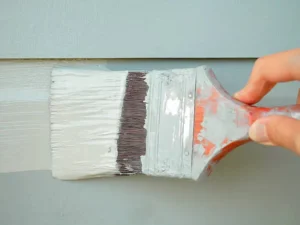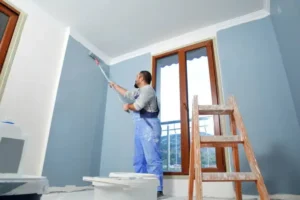Have you ever grabbed a can of paint from your garage only to wonder if it’s the right type for your project? I’ve been there too. Standing in the paint aisle, faced with endless options labeled “interior” and “exterior,” can leave anyone scratching their head. What’s actually different about these products anyway?
As it turns out, quite a lot! Understanding the difference between interior and exterior paint can make or break your home improvement project, affecting everything from durability to appearance and even your family’s health.
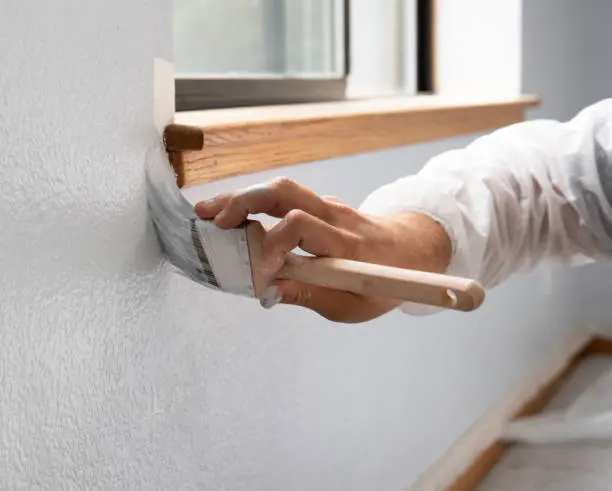
Why Interior and Exterior Paints Aren’t Interchangeable
Let me tell you about my neighbor who learned this lesson the hard way. Last summer, he decided to save a few bucks by using leftover interior paint on his porch columns. By winter, the once-beautiful white finish had cracked, peeled, and turned a mess, all because he didn’t understand the difference between interior and exterior paint and how crucial it is for durability and weather resistance.
Paint isn’t just paint. These products are carefully engineered for specific environments, and using the wrong type is like wearing flip-flops in a snowstorm—technically possible, but definitely not recommended!
The Science Behind Interior Paint
Interior paint is designed specifically for the controlled environment inside your home. Without exposure to harsh weather conditions, these formulations focus on different qualities:
What makes interior paint special?
- Low VOCs (Volatile Organic Compounds) – Since indoor air quality matters, quality interior paints have fewer harsh chemicals that can off-gas into your living space
- Stain resistance – Because who hasn’t had to clean mysterious marks off walls?
- Scuff resistance – Especially important in high-traffic areas like hallways
- Easy cleaning – Many interior paints can handle regular washing without fading
- Smooth, refined finish – Interior paints are designed to look good up close, where you’ll be seeing them every day
Interior paint generally contains softer resins that allow for better stain removal without damaging the paint film. Understanding the difference between interior and exterior paint is key here because this softness would be a liability outdoors, but serves perfectly well in your temperature-controlled living room.
Think about your bathroom or kitchen walls—they need to withstand moisture and occasional cleaning without deteriorating. A good interior paint makes this possible while still looking beautiful year after year.
The Engineering Behind Exterior Paint
If interior paint is like comfortable indoor clothing, exterior paint is like heavy-duty outdoor gear designed to brave the elements.
What makes exterior paint tough?
- UV resistance – Protects against sun damage and color fading
- Moisture resistance – Keeps water from penetrating your home’s exterior surfaces
- Temperature flexibility – Expands and contracts with your house as temperatures change
- Mildew resistance – Fights off biological growth in damp conditions
- Enhanced durability – Stands up to wind, rain, and other environmental challenges
Have you ever noticed how outdoor paint feels different when you touch it? That’s because exterior paints contain harder resins and additional binding agents that help them grip outdoor surfaces more effectively, highlighting the difference between interior and exterior paint and why each is specially formulated for its environment.
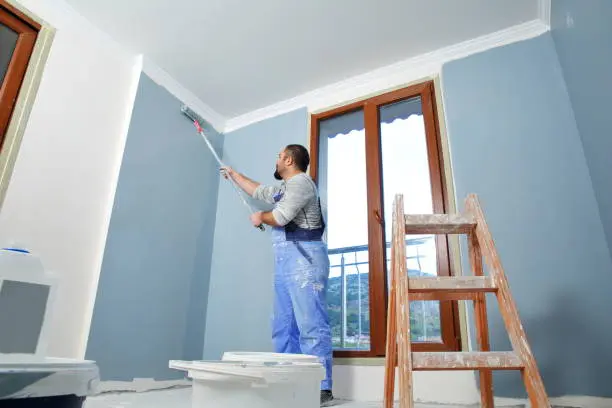
Breaking Down The Key Differences
Let’s get specific about what separates these two types of paint:
1. Ingredients and Formulation
Interior Paint:
- Contains resins that are softer but allow for better stain removal
- Features minimal amounts of mildewcides and fungicides
- Optimized for appearance and color stability in controlled environments
- Often includes ingredients to reduce odor during application
Exterior Paint:
- Contains harder, more rigid resins that resist cracking
- Higher concentrations of mildewcides and fungicides to prevent growth
- Includes UV-resistant pigments and additives
- Features enhanced binding agents for stronger adhesion
2. Durability Factors
Interior Paint:
- Withstands occasional cleaning and light scrubbing
- Designed for consistent temperature and humidity levels
- Protected from direct sunlight and weather exposure
- Focus on resistance to indoor challenges (cooking stains, handprints)
Exterior Paint:
- Withstands temperature swings from freezing to blistering hot
- Resists rain, snow, and high humidity without peeling
- Shields against UV radiation that would quickly fade interior formulations
- Stands up to dirt, pollution, and organic matter
3. Application and Drying Differences
When I tackled my living room walls last spring, I was able to apply the interior paint and use the room the next day. My exterior painting project, however, required careful planning around the weather forecast and took longer to fully cure.
Interior Paint:
- Generally dries faster than exterior paint
- Often requires fewer coats for full coverage
- Typically lower in odor due to lower VOC content
- Usually easier to apply smoothly
Exterior Paint:
- Takes longer to dry completely and cure
- Usually requires more thorough surface preparation
- Often needs more coats for adequate protection
- The application may be affected by outdoor temperature and humidity
How To Choose The Right Paint For Your Project
Selecting the right paint isn’t just about picking “interior” or “exterior”—there are several factors to consider:
For Interior Projects:
- Room function – Kitchens and bathrooms benefit from moisture-resistant, washable formulations
- Traffic level – High-traffic areas need more durable, scuff-resistant finishes
- Lighting conditions – Natural vs. artificial light affects how colors appear
- Health concerns – Consider zero-VOC options for nurseries or if you have allergies
For Exterior Projects:
- Surface material – Different exteriors (wood, vinyl, brick) require specific formulations
- Local climate – Coastal homes face different challenges from desert dwellings
- Sun exposure – South and west-facing walls get more UV damage
- Architectural features – Trim, doors, and accents may need specialized paint
Remember the house down the street that always looks freshly painted? I chatted with the owner and learned they chose a premium exterior paint specifically formulated for our region’s weather patterns. That smart move shows how knowing the difference between interior and exterior paint can help maintain a home’s appearance and durability over time.
The Cost Factor: Is Premium Paint Worth It?
Let’s talk dollars and cents. While premium paints (both interior and exterior) cost more upfront, they often save money in the long run.
Value calculations to consider:
- Premium interior paints typically cover in fewer coats, saving on material
- Higher-quality exterior paints often last years longer before needing repainting
- Better coverage means less time spent on the project
- Improved durability reduces maintenance costs over time
Common Painting Mistakes to Avoid
We all make mistakes, but some painting errors can be costly. Here are pitfalls to avoid:
Interior painting missteps:
- Skipping primer on porous or stained surfaces
- Using flat paint in high-moisture areas like bathrooms
- Applying paint too thickly, leading to drips and uneven drying
- Forgetting to test colors in the actual room lighting
Exterior painting errors:
- Painting during extreme temperatures or high humidity
- Inadequate surface preparation (this is where most failures occur!)
- Using interior paint for exterior projects (there’s that one again)
- Painting over rotten wood or damaged surfaces
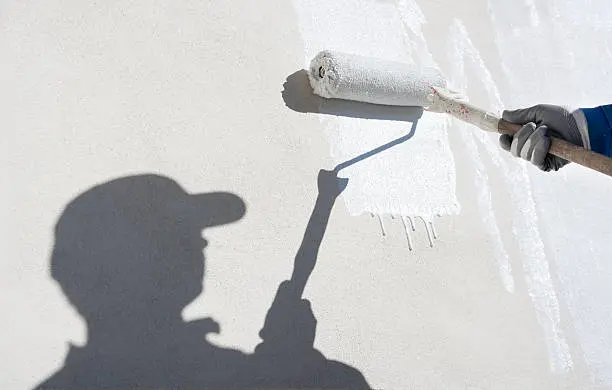
Environmental and Health Considerations
The paint you choose affects more than just your home’s appearance—it impacts your environment and health too.
Indoor air quality:
- Interior paints with high VOC levels can off-gas chemicals for months
- Low and zero-VOC options have improved dramatically in quality
- Consider natural paint alternatives for extremely sensitive individuals
Environmental impact:
- Look for paints with environmental certifications
- Water-based formulations typically have less environmental impact
- Proper disposal of paint cans and leftovers prevents contamination
Professional vs. DIY Painting Projects
While many painting projects are perfect for DIY enthusiasts, others might benefit from professional expertise.
When to DIY:
- Smaller interior rooms with accessible walls and ceilings
- Touch-up projects and accent walls
- When you have adequate time and proper tools
- If you enjoy the painting process (I find it oddly therapeutic!)
When to call professionals:
- Multi-story exterior projects requiring tall ladders or scaffolding
- Historic homes with special considerations
- When time constraints make DIY impractical
- For perfect finishes in formal or highly visible areas


